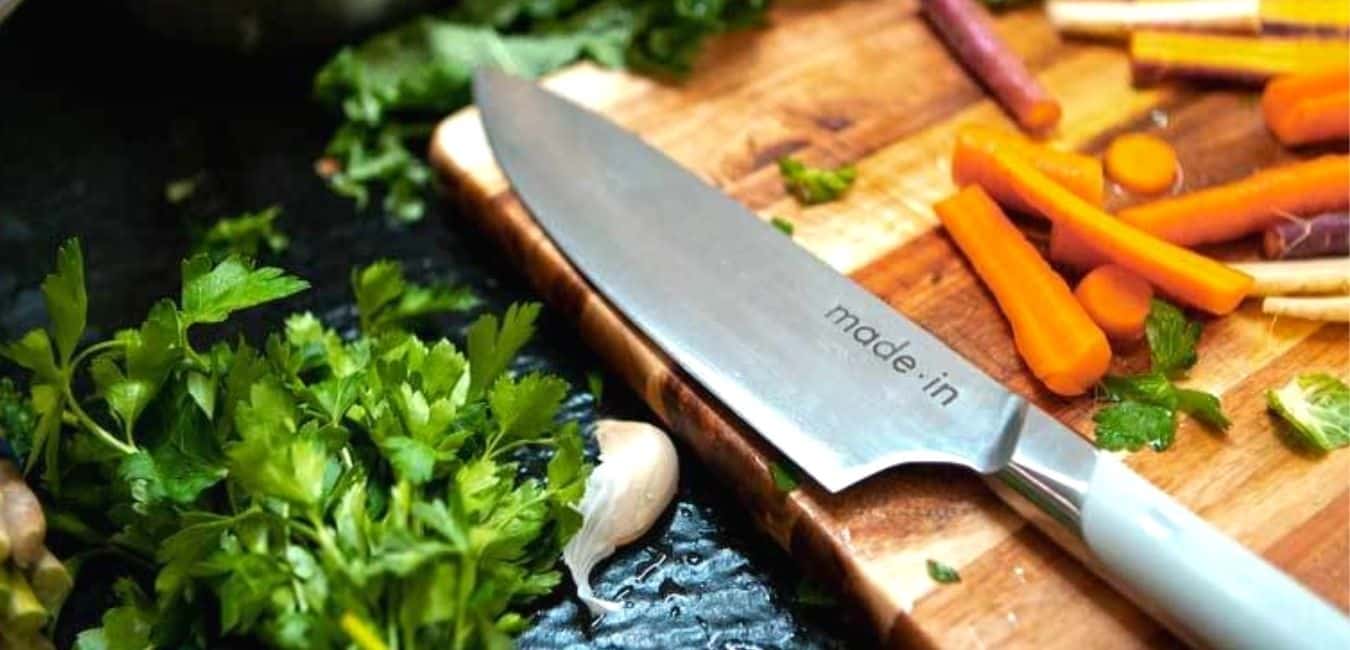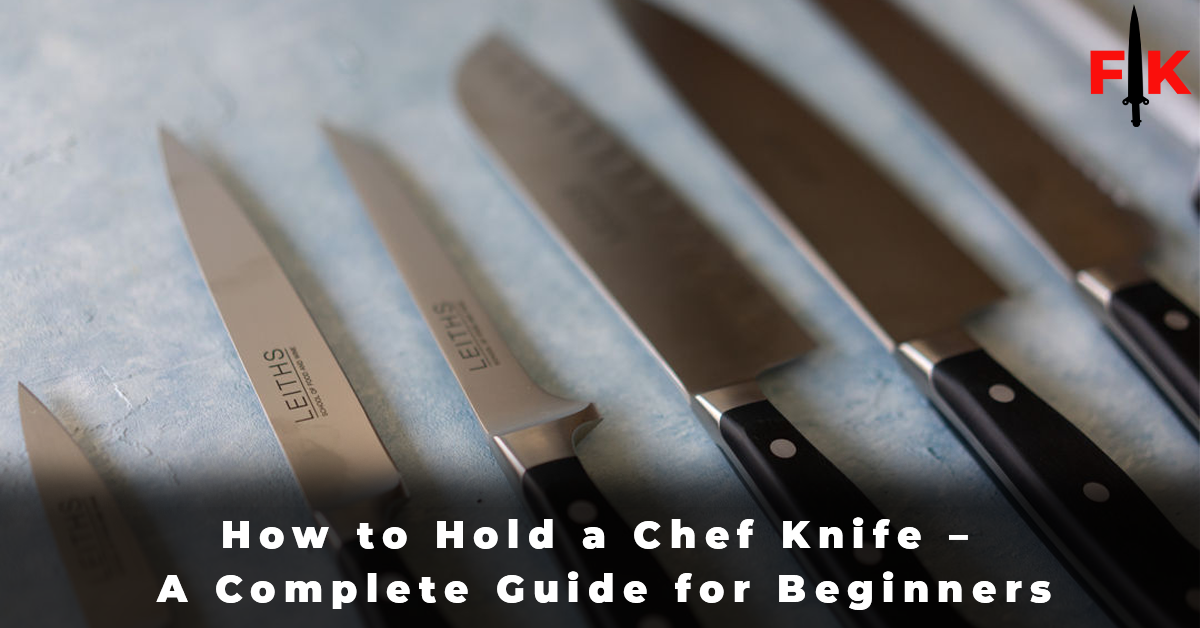Chef knives are your best kitchen partner because they are so flexible and when held and wielded correctly, a chef’s knife is more advantageous in the kitchen.
But before this, you should know what does a chef’s knife does? A chef knife’s curved blade allows it to rock back and forth on a chopping board which is ideal for chopping and dicing vegetables, fruits, and herbs. As well as also ideal for cutting a variety of other foods such as meat, poultry, and fish. They are typically 8 to 10 inches long, with a rounded tip.
Now if you want that your chef knife performs its function efficiently so you should know the proper way to hold a chef knife. If you hold it in the wrong way, it won’t work right. A good grip will give you more control, enhancing cutting accuracy and speed while limiting slippage and reducing the likelihood of accidents.
The best technique to hold a chef knife is to wrap the remaining three fingers around the handle and grab the heel of the blade with your thumb and forefinger. More details about how to hold your chef knife properly will be discussed in this article. So let’s get started.
Table of Contents
How to Properly Hold a Chef Knife?
The handle grip and the blade grip are the two most common Chef Knife grips. If you’ve only ever used the handle grip, try the other one—your cuts might improve substantially. If you want a video demonstration of holding a chef knife properly so watch the video below.
Let’s discuss here both the way to hold your knife:
1. Handle Grip:
The Handle Grip, Front View:
Your hand is totally behind the bolster on the handle itself while using the handle grip. It is typically utilized by inexperienced cooks or by cooks with unusually small hands. It’s comfy; however, it only gives you a limited amount of control while conducting precision knife work.
The Handle Grip, Back View
Same grip, from the back. Every finger is nestled beneath the bolster.
2. Blade or Pinch Grip:

The Blade or Pinch Grip, Front View
For more experienced cooks, the Knife pinch grip or blade grip is the ideal grip. Your thumb and forefinger should be directly on the blade in front of the bolster (the point where the metal expands out to meet the handle).
Instead of wrapping all of your fingers around the handle, only wrap your pinky, index, and middle finger. Place your bent pointer finger on one side of the blade and your thumb on the other, as if you were pinching the blade between them.
While this will require some experience and may feel unpleasant at first, it will allow you to make thinner, straighter cuts.
It’s a touch daunting, but it provides far more control and balance. On inferior stamped knives without a bolster, this grip may be difficult and/or uncomfortable.
The Blade Grip, Back View:
Same grip, from the back. Notice the first finger is in front of the bolster.
The Claw:
Always cut foods in a stable position, preferably with the cut surface flat against the cutting board. With your free hand, guide the knife blade against the meal. Protect your fingertips by curling them inwards and guiding your knife with your knuckles.
Mincing:
A fine mince necessitates the use of one’s free hand. Place the tip of your knife on the cutting board and secure it with your free hand. Rock the blade up and down to finely mince herbs (or anything else).
What is a Chef’s Knife Used for?

Did you know that you can use more than just the blade’s sharp edge to help you cook tasty meals? With some practice and a little imagination, you’ll learn that your chef knife may be utilized in a variety of ways — just be sure to familiarize yourself with the various elements of a knife.
Using the Blade’s Tip:
There’s a reason why the tip of a chef’s knife comes to a sharp point, there are several, ranging from meat preparation to baking goodies!
Preparing Meats: As previously said, the chef’s knife is a must-have for meat preparation – and the tip comes in handy, too! Remove sinew from meat using the sharp edge of your chef’s knife – the tough fibrous tissue (tendon or ligament) that connects muscles to bones or bones to bones. A boning knife is excellent for the process, but if you don’t have one, grab for your chef’s knife!
Baking Treats: If you enjoy baking, go a little fancy with your sweet treats by cutting creative shapes into pastries and cookie dough with the point of your chef’s knife!
Making Guides: For others, cutting anything evenly is an art form in and of itself (). If you have trouble slicing through dense fruits and vegetables like pumpkins, butternut squash, and other fall vegetables, as well as fruits like honeydew and watermelon, draw guide cuts with the tip of your chef’s knife to avoid serving up mangled fruits and vegetables. Then, using the guidelines, slice those babies up into precisely level pieces.
Using the Blade’s Flat:

This is where you may have some additional fun during your cooking excursions. There’s something quite fulfilling about bashing items with the flat of a chef’s knife. Here are a few options for obtaining that satisfaction:
Crushing Garlic: Many recipes call for crushed garlic, which may be done quickly and easily with a chef’s knife. Pull a few cloves from the head and peel back the natural paper wrapper – or smack it under the flat of your knife to make it easier to peel.
Once the garlic cloves are loose, smash them with the flat of your knife one at a time. Place the blade on its side with the garlic clove underneath and presses down gently with your hand, being careful not to contact the sharp cutting edge. It will take some practice, but once you’ve perfected the method, breaking down garlic will be a breeze.
Cucumber Crushing: Crushed cucumber? Yes! Cucumbers may absorb other tastes in a meal and become considerably more flavorful with a little gentle crushing – a method widely utilized in Asian cuisine. To crush a cucumber with your chef’s knife, first, slice it into pieces (if it’s a huge cucumber), then gently push down on each piece with the flat of your blade. You’ll notice some water puddles on your board, which is fine because that’s the idea! Simply slice it up once you’ve finished softly smashing each piece. Chop it up, or make whatever cut the recipe requires!
Using the Blade’s Spine:

There are a few times when you’ll want to use the other side of the cutting edge of your chef’s knife blade. The spine of your chef’s knife blade is the star of the show, whether you’re scaling fish or breaking a coconut.
Scaling Fish: To scale a fish, just grasp the tail and use a stroking motion to scrape the spine of your chef’s knife along with the scales of the fish from tail to head. After you’ve removed all of the scales, properly wash your fish and you’re ready to go!
Holding a Chef knife – FAQs
Conclusion:
Learning how to properly hold a chef’s knife will keep you and your fingers safe. It can also help you chop faster and more efficiently, just like the experts! I hope this guide helps you a lot in holding your chef knife properly!



